

Pre-Vietnam War
Variations of the legend of Nui Ba Den exist. Most center around a woman, Ba Den, falling in love with a soldier and then through betrayal or suicide Ba Den dies on the mountain. It has special significance to the Vietnamese Buddhist population and has a famous shrine about two thirds of the way up the mountain. Also, to the Cao Dai sect the mountain has special religious significance and its temple, the Tay Ninh Holy See, is close to the mountain. During World War II the mountain was occupied by the Japanese and it was occupied by the Viet Minh, the French and the Viet Cong.
Vietnam War
The Mekong Delta is generally a flat region with the exception of the Black Virgin Mountain. The mountain commands everything in its sight and was therefore a strategic location for both sides during the war. In 1964 the mountain top was assaulted by special forces and the peak was held by American forces as a radio relay station. Supplied by helicopter for much of the war the Americans controlled the top and the Viet Cong (VC) controlled the bottom and surrounding plain.
On May 13,1968 the station was overrun by the VC, who killed 21 Americans manning the station. At this time most of the elements that manned the radio station were not infantry, but signalmen and staff types from the 125th Signal Battalion. There were a few guys from the 2-18th and 4-9th as well. The morning of 5-14, A Co 2-12th arrives to reinforce the mountain. The relay station was attacked again on August 18, 1968 and American losses were 8 KIA's in that battle; three men from the 125th Signal Bn and 5 men from the 3-22nd Inf. In January 1969 the mountain was extensively searched by 1st Brigade elements of the 3rd Battalion, 22nd Infantry regulars, 4th Battalion 23rd Infantry and tanks from the 2nd Battalion, 34th Armour. In the tunnels that honeycombed the mountain they found arms caches, and engaged VC units stationed on the mountain. Once more, on June 19, 1969 the complex came under a sapper attack.Throughout the war the VC returned to the mountain and its cave bases. Colonel Donald Cook was the first Marine captured in the Vietnam war. For a time he was held near Black Virgin mountain. In 1973 the mountain was closed as an American base. During the closing days of the war when the mountain was abandoned by Army of the Republic of Vietnam (ARVN) troops the local population left the region afraid of the approaching communist soldiers.
Variations of the legend of Nui Ba Den exist. Most center around a woman, Ba Den, falling in love with a soldier and then through betrayal or suicide Ba Den dies on the mountain. It has special significance to the Vietnamese Buddhist population and has a famous shrine about two thirds of the way up the mountain. Also, to the Cao Dai sect the mountain has special religious significance and its temple, the Tay Ninh Holy See, is close to the mountain. During World War II the mountain was occupied by the Japanese and it was occupied by the Viet Minh, the French and the Viet Cong.
Vietnam War
The Mekong Delta is generally a flat region with the exception of the Black Virgin Mountain. The mountain commands everything in its sight and was therefore a strategic location for both sides during the war. In 1964 the mountain top was assaulted by special forces and the peak was held by American forces as a radio relay station. Supplied by helicopter for much of the war the Americans controlled the top and the Viet Cong (VC) controlled the bottom and surrounding plain.
On May 13,1968 the station was overrun by the VC, who killed 21 Americans manning the station. At this time most of the elements that manned the radio station were not infantry, but signalmen and staff types from the 125th Signal Battalion. There were a few guys from the 2-18th and 4-9th as well. The morning of 5-14, A Co 2-12th arrives to reinforce the mountain. The relay station was attacked again on August 18, 1968 and American losses were 8 KIA's in that battle; three men from the 125th Signal Bn and 5 men from the 3-22nd Inf. In January 1969 the mountain was extensively searched by 1st Brigade elements of the 3rd Battalion, 22nd Infantry regulars, 4th Battalion 23rd Infantry and tanks from the 2nd Battalion, 34th Armour. In the tunnels that honeycombed the mountain they found arms caches, and engaged VC units stationed on the mountain. Once more, on June 19, 1969 the complex came under a sapper attack.Throughout the war the VC returned to the mountain and its cave bases. Colonel Donald Cook was the first Marine captured in the Vietnam war. For a time he was held near Black Virgin mountain. In 1973 the mountain was closed as an American base. During the closing days of the war when the mountain was abandoned by Army of the Republic of Vietnam (ARVN) troops the local population left the region afraid of the approaching communist soldiers.
Black Virgin Mountain (Vietnamese: Núi Bà Ðen, French: Montagne de la Dame Noire, both meaning "Black Lady Mountain") is a mountain in the Tay Ninh Province of Vietnam. To the Vietnamese the mountain is the center of a myth about Ba Den, a Vietnamese woman. During the Vietnam War the area around the mountain was very active as the Ho Chi Minh Trail ended a few kilometers west across the Cambodian border. As such there were many battles and American and Vietnamese soldiers based in the region remember the prominent land mark. After the war the mountain turned from a battle ground to being famous for the its beautiful temples and theme park. There are trails to hike up the mountain but many people take the Nui Ba Den gondola lift to the top.
At 996 meters (3,268 ft), the extinct volcano rises from the flat Mekong Delta jungle and farmland. The mountain is almost a perfect cinder cone with a saddle and a slight bulge on her Northwest side. The mountain is honeycombed with caves and is covered in many large basalt boulders.
At 996 meters (3,268 ft), the extinct volcano rises from the flat Mekong Delta jungle and farmland. The mountain is almost a perfect cinder cone with a saddle and a slight bulge on her Northwest side. The mountain is honeycombed with caves and is covered in many large basalt boulders.
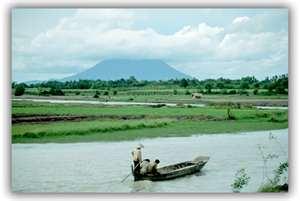


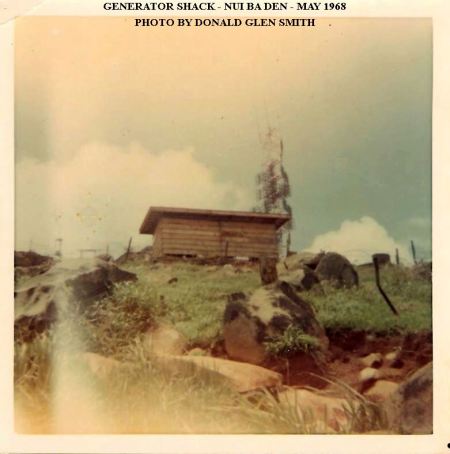

Generator Shack Bunker #9

Mess Hall




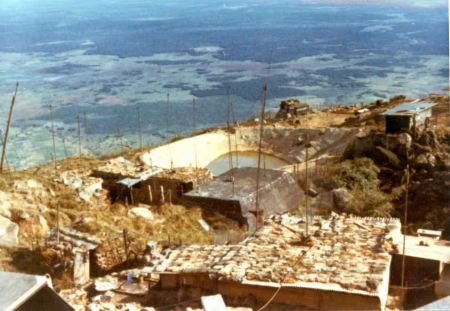
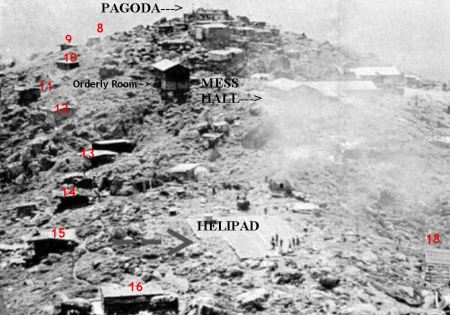
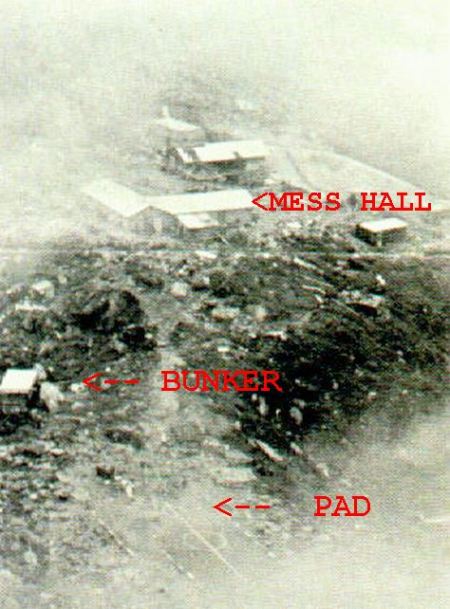
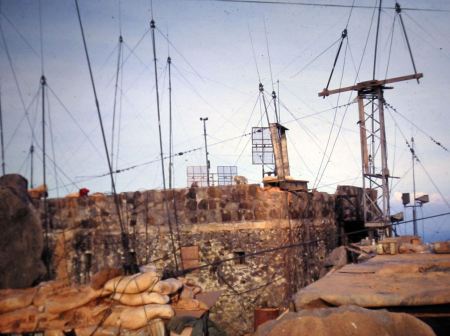
Antenna arrays
Bunker
Rocks and bunker
Aerial photo of site
Reservoir
Aerial phot of main camp area
Helipad
Orderly Room
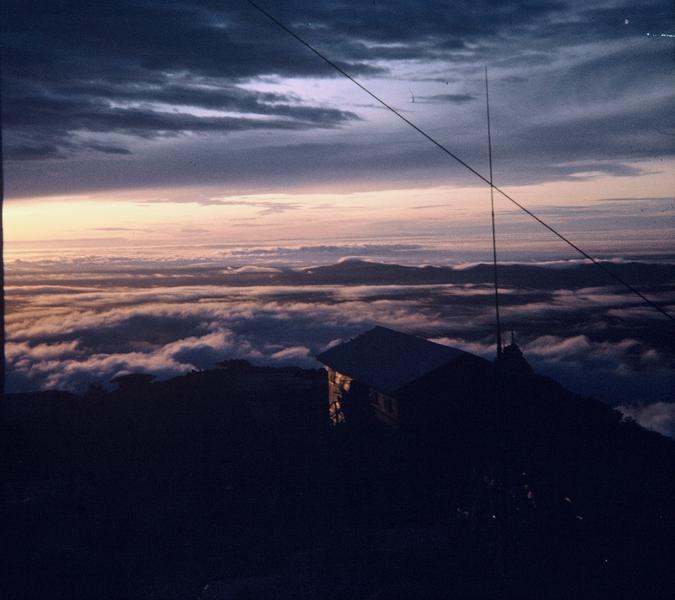
All is quiet - for now
Everyone who served in III and IV Corp recognizes this landmark. From the time the USA entered the war, this mountain served as it's own battleground. Used as a radio relay station, everyone wanted to own this piece of real estate. We lost a lot of troops to the VC manning this station as you will read about later.
We flew by her, walked by her, went to sleep under her shadow and for a precious few, set foot on the top of her crown. Nui Ba Den was always there and each day, she would wear a different look. Clear and sparkling, sometimes blue or purple, maybe a shade of gray haze and sometimes she adorned a nice hat of clouds. She was our beacon of direction and told us where we were. From afar, then, as she is now, she continues to be a site of splendour and grace. - Sarge
We flew by her, walked by her, went to sleep under her shadow and for a precious few, set foot on the top of her crown. Nui Ba Den was always there and each day, she would wear a different look. Clear and sparkling, sometimes blue or purple, maybe a shade of gray haze and sometimes she adorned a nice hat of clouds. She was our beacon of direction and told us where we were. From afar, then, as she is now, she continues to be a site of splendour and grace. - Sarge



